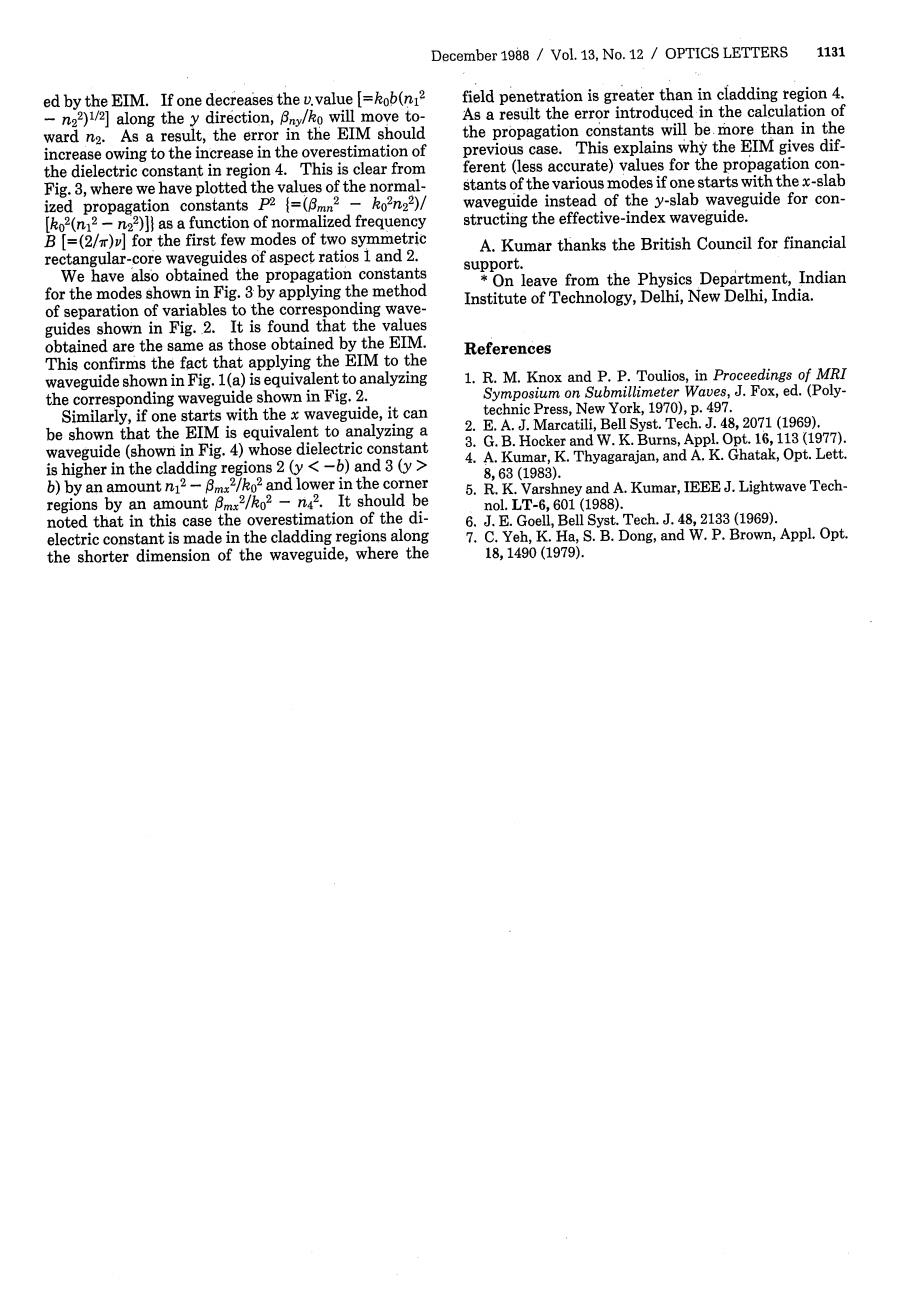正在加载图片...

December 1988 Vol.13,No.12 OPTICS LETTERS 1131 ed by the EIM.If one decreases the v.value [=kob(n12 field penetration is greater than in cladding region 4. -n22)1/2]along the y direction,Bny/ko will move to- As a result the error introduced in the calculation of ward n2.As a result,the error in the EIM should the propagation constants will be.more than in the increase owing to the increase in the overestimation of previous case.This explains why the EIM gives dif- the dielectric constant in region 4.This is clear from ferent (less accurate)values for the propagation con- Fig.3,where we have plotted the values of the normal- stants of the various modes if one starts with the x-slab ized propagation constants p2 {=(8mn2 -ko2n22)/ waveguide instead of the y-slab waveguide for con- [ko2(n2-n22)]as a function of normalized frequency structing the effective-index waveguide. B [=(2/T)v]for the first few modes of two symmetric A.Kumar thanks the British Council for financial rectangular-core waveguides of aspect ratios 1 and 2. We have also obtained the propagation constants support. On leave from the Physics Department,Indian for the modes shown in Fig.3 by applying the method of separation of variables to the corresponding wave- Institute of Technology,Delhi,New Delhi,India. guides shown in Fig.2.It is found that the values obtained are the same as those obtained by the EIM. References This confirms the fact that applying the EIM to the waveguide shown in Fig.1(a)is equivalent to analyzing 1.R.M.Knox and P.P.Toulios,in Proceedings of MRI the corresponding waveguide shown in Fig.2. Symposium on Submillimeter Waves,J.Fox,ed.(Poly- Similarly,if one starts with the x waveguide,it can technic Press,New York,1970),p.497. be shown that the EIM is equivalent to analyzing a 2.E.A.J.Marcatili,Bell Syst.Tech.J.48,2071(1969). waveguide (shown in Fig.4)whose dielectric constant 3.G.B.Hocker and W.K.Burns,Appl.Opt.16,113(1977). is higher in the cladding regions 2(y <-b)and 3(y 4.A.Kumar,K.Thyagarajan,and A.K.Ghatak,Opt.Lett. 8.63(1983). b)by an amount n2-8mx2/ko2 and lower in the corner 5.R.K.Varshney and A.Kumar,IEEE J.Lightwave Tech- regions by an amount 8mx2/ko2-n42.It should be nol.LT-6,601(1988). noted that in this case the overestimation of the di- 6.J.E.Goell,Bell Syst.Tech.J.48,2133(1969). electric constant is made in the cladding regions along 7.C.Yeh,K.Ha,S.B.Dong,and W.P.Brown,Appl.Opt. the shorter dimension of the waveguide,where the 18,1490(1979).December 1988 / Vol. 13, No. 12 / OPTICS LETTERS 1131 ed by the EIM. If one decreases the v.value [=kob(ni2 - n2 2)'/ 2] along the y direction, 3ny/ko will move toward n2. As a result, the error in the EIM should increase owing to the increase in the overestimation of the dielectric constant in region 4. This is clear from Fig. 3, where we have plotted the values of the normalized propagation constants p2 {= (13mn2 - ko2n2 2)/ [ko2(n1 2 - n2 2)]1 as a function of normalized frequency B [=(2hr)v] for the first few modes of two symmetric rectangular-core waveguides of aspect ratios 1 and 2. We have also obtained the propagation constants for the modes shown in Fig. 3 by applying the method of separation of variables to the corresponding waveguides shown in Fig. 2. It is found that the values obtained are the same as those obtained by the EIM. This confirms the fact that applying the EIM to the waveguide shown in Fig. 1(a) is equivalent to analyzing the corresponding waveguide shown in Fig. 2. Similarly, if one starts with the x waveguide, it can be shown that the EIM is equivalent to analyzing a waveguide (shown in Fig. 4) whose dielectric constant is higher in the cladding regions 2 (y < -b) and 3 (y > b) by an amount n1 2 - l.mx2/ko 2 and lower in the corner regions by an amount flmx2/ko2 -f4 2. It should be noted that in this case the overestimation of the dielectric constant is made in the cladding regions along the shorter dimension of the waveguide, where the field penetration is greater than in cladding region 4. As a result the error introduced in the calculation of the propagation constants will be. more than in the previous case. This explains why the EIM gives different (less accurate) values for the propagation constants of the various modes if one starts with the x-slab waveguide instead of the y-slab waveguide for constructing the effective-index waveguide. A. Kumar thanks the British Council for financial support. * On leave from the Physics Department, Indian Institute of Technology, Delhi, New Delhi, India. References 1. R. M. Knox and P. P. Toulios, in Proceedings of MRI Symposium on Submillimeter Waves, J. Fox, ed. (Polytechnic Press, New York, 1970), p. 497. 2. E. A. J. Marcatili, Bell Syst. Tech. J. 48, 2071 (1969), 3. G. B. Hocker and W. K. Burns, Appl. Opt. 16, 113 (1977). 4. A. Kumar, K. Thyagarajan, and A. K. Ghatak, Opt. Lett. 8, 63 (1983). 5. R. K. Varshney and A. Kumar, IEEE J. Lightwave Technol. LT-6,601 (1988). 6. J. E. Goell, Bell Syst. Tech. J. 48, 2133 (1969). 7. C. Yeh, K. Ha, S. B. Dong, and W. P. Brown, Appl. Opt. 18,1490 (1979)